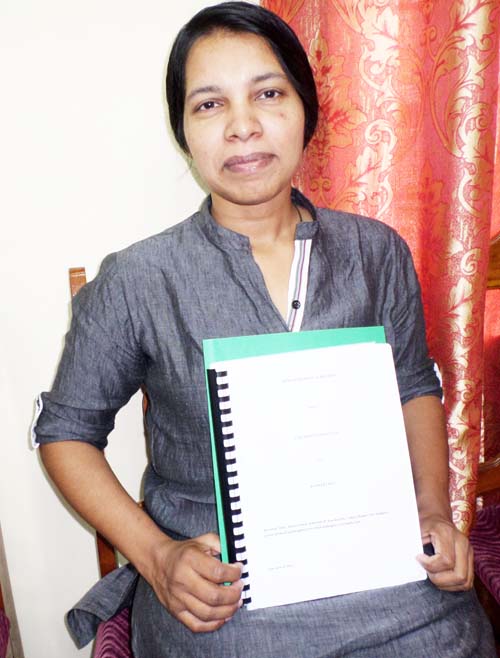Research ongoing for ‘natural’ treatment for Diabetic Foot
July 28, 2015 | By KNews | Filed Under News, Source
Diabetic foot care has long been recognised as an area of health care that attracts a sizeable sum, globally. It is nevertheless a very crucial undertaking.
While reducing cost for treating this condition may not be realised any time soon, local attempts are however being made to uncover a more natural treatment method.
Through a grant awarded last week through the US$10 million World Bank-funded University of Guyana Science and Technology Support Project (UGSTSP), lecturer attached to the Faculty of Health Sciences, Rajini Kurup, will be aiming to derive a natural diabetic foot treatment.
Entitled ‘Investigating the antimicrobial potential of azardirachta indica (also known as neem or nimtree) and syzygium cumini (commonly known as jamoon) seeds against microbial pathogens in diabetic foot’, the project is one that will see Kurup collaborating with key officials.
She named Dean of the Faculty of Natural Sciences, Dr. Adil Ansari, and Director of the Diabetic Foot Centre at the Georgetown Public Hospital, Dr. Kumar Sukhraj.
The investigative process will entail efforts being directed to separating microorganisms from the diabetic foot patient, according to Kurup, who explained that attempts will then be made to see if chemicals from the two seeds can work as antimicrobial agents. “If it is effective, we could cut down on the usage of the chemical antibiotics that patients use day after day…We can instead use natural treatment,” asserted Kurup.
“Dr. Sukhraj will be working closely with us to extract microbial and micro-organisms from diabetic foot patients,” said Kurup as she explained that the extracts will be tested in a laboratory for antimicrobial susceptibility. This is in essence a test to determine whether the property of the seeds can in fact serve as an antimicrobial agent.
Kurup, who hails from India, is a trained microbiologist who has been practising in this field for several years. She claims to have engaged in a number of research projects but noted that “this is the first time that I am doing something with a natural product to see if it can be effective…”
She added, “I have been seeing lots of microbial agents that are getting into the system that are not working with the antibiotics and so on, and so I wanted to try and see how this (natural method) will work.”
Several studies, according to her, have shown that the seeds under scrutiny have good microbial properties but (arguably) no study has been done to determine their antimicrobial potential.
The project, which has already commenced, is slated to come to an end by next year end. It is among a total of nine investigative research projects being undertaken under the UGSTSP.
The other projects include: Determination of aflatoxins in paddy, rice and rice by-products in Guyana; assessing prehistoric diet breadth and settlement to model a low carbon life way; examining the impact of mining on fish diversity and diet in coastal and inland rivers of Guyana; assessing the ‘Greenness’ of the Guyanese population and its relation to green space; designing a Dual Approach Composite Material(DACM) filter for household water treatment; Assessing the wind energy potential on Guyana’s coastland; examining architectural and urban adjustments for the effective harvesting of LCDS benefits; and exploring the integration of environmental education in the mathematics curriculum.
A total of eight grants were last year awarded under the UGSTSP. They included: Estimating the carbon storage potential of the mangrove forests in Guyana; Analysing the culture and propagation of edible mushrooms on different organic substrates in Guyana; Investigating the impacts of artisanal and small-scale mining and their associated road infrastructure on biodiversity in the Frenchman, Region Eight mining district; Studying the effects of educational intervention about “bush medicine” on the knowledge, attitudes and practices of Pharmacists and Physicians; Investigating the effects of momordica charantia (carilla) on secondary and primary cancer cell lines; Studying antimicrobial activities of selected fruits and vegetables against selective pathogenic micro-organisms; An experimental approach to economic behaviour, culture and institutions in support of low carbon development; and Investigating the use of solar generated steam power in the University’s thermodynamics laboratory.
The 2014 grants commenced in March, 2014 and the researches are expected to be completed by December, 2015.
It is expected that their results will lead to the formulation of public policy recommendations; development of LCDS-relevant services and products; generation of field research skills among academics at the University; and the production of baseline information against which the impact of economic activities can be measured.
A study is also on-going for the establishment of a research and innovation fund at the University. Once established, this fund will facilitate the sustainability of opportunities for research and knowledge generation for the University and the wider Guyanese society.

